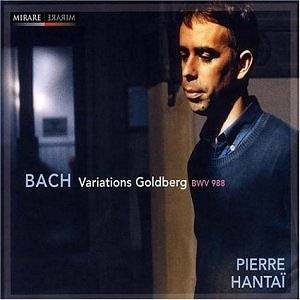Comparison Version: Hantaï
(Opus 111/Naïve)
In 1993 Pierre Hantaï
recorded Bach’s Goldberg Variations
for Opus 111, now reissued on the Naïve
label - review.
The performance was outstanding and
garnered a great deal of praise and
awards. After a break of a little more
than ten years, Hantaï gives us
his second recording of Bach’s monumental
set of variations.
Classical music enthusiasts
often question the need for dozens of
versions of one piece of music, and
the skepticism concerning multiple versions
from the same performing artist is equally
strong. Therefore, the immediate issue
with the new Hantaï disc is whether
he has anything new to say about the
Goldberg Variations. From this reviewer’s
perspective, the answer is a resounding
‘yes’.
Hantaï’s 1993
performance is a treasure for its joy
and vitality delivered in a highly fluid
manner. In the new interpretation, Hantaï
is less exuberant with a bittersweet
element now conveyed in the Aria and
many of the variations. The readings
are darker and richer in emotional content,
as he explores phrases and motifs with
a sense of improvisation. Pacing tends
to be slower than in the earlier recording,
and contours are much sharper. Further,
he uses more rhythmic hesitations and
tempo changes than before.
The above considerations
do not necessarily add up to a declaration
that the new recording surpasses the
earlier one. The two interpretations
are simply different in conception and
equally compelling. I would hate to
be without the unbridled joy and lift
of the 1993 performance, and the new
one is essential for its greater breadth
of emotional content and stronger rhythmic
stretching achieved through incisive
accenting and inflections. The constants
in both performances are a complete
service to Bach’s soundworld and a consistency
of excellence rarely encountered in
alternative recordings.
Here are a few highlights
that I feel best indicate the distinctions
between the two Hantaï recordings:
Aria – Significant
differences surface immediately in the
opening Aria. The earlier version lasts
slightly over 4 minutes, while the new
one takes almost five minutes. Hantaï
‘93’ is comforting and optimistic; Hantaï
‘2003’ is bittersweet to the core and
rich in emotional layering.
Variations 3 through
8 – Hantaï is positively radiant
and bubbling with enthusiasm in the
earlier recording, but the new one finds
him tempering the bubbling effect with
emotional themes of less joyous magnitude.
Both approaches are irresistible.
Variation 9 –
Hantaï goes from spiritually uplifting
in ‘93’ to a slower tempo with hesitations
conveying a personality of nagging doubts,
an interpretation that is darker and
emotionally richer than the earlier
one.
Variations 13 and
15 – The new version has the clear
advantage. An improvisatory presentation
makes the dialogue more spontaneous
and realistic in Variation 13, and Hantaï
now offers layers of dark emotional
content in Variation 15 that contrast
more effectively with the one radiant
passage found in the second section.
Variation 16 –
I have to make special mention of the
new Hantaï performance. This is
the Overture with its heroic double-dotted
rhythms followed by an invigorating
fugue. Hantaï drenches the music
with sharply pungent phrasing, and his
fugue is a whirlwind of powerful and
detailed activity. The performance might
well be the best on record, and it is
certainly the sharpest and most compelling
interpretation I’ve ever heard.
Variation 28 –
Both Hantaï accounts are excellent
examples of his fantastic virtuosity,
precision, and expressiveness. The finger
work and articulation are simply amazing.
In summary, the new
Hantaï recording of the Goldberg
Variations is amongst the best on record.
The increased maturity of his interpretation
over the 1993 recording is apparent
in the richer and more diverse emotional
palette, improvisatory presentation
and variety of tempos and rhythms. This
is a ‘must buy’ for anyone not allergic
to the harpsichord.
In addition to the
two Hantaï performances being of
different conception, the harpsichords
used add to the distinctions. In the
1993 performance, Hantaï’s choice
of instrument is a very warm-sounding
Dutch Bruce Kennedy model. In the new
performance, Hantaï plays a Jonte
Knif German model that is sharper and
more detailed than the Dutch model.
One does hear some mechanical action
from the Knif harpsichord, but the effect
is not distracting.
Assuming that monetary
considerations are not limiting, I strongly
suggest that readers acquire both Hantaï
recordings and revel in one of the greatest
keyboard works ever created.
Don Satz


